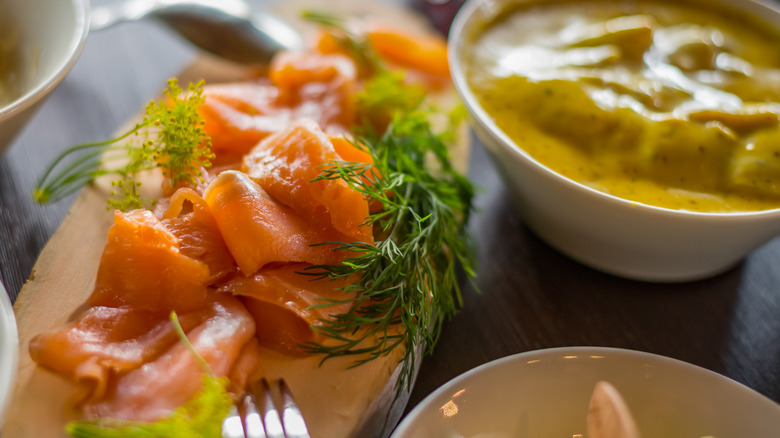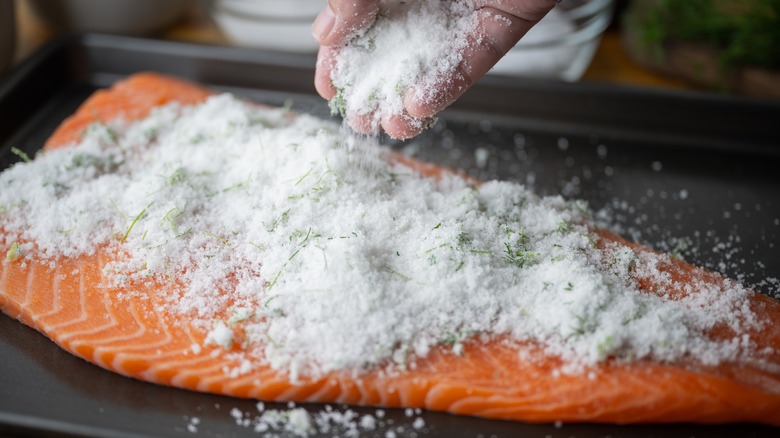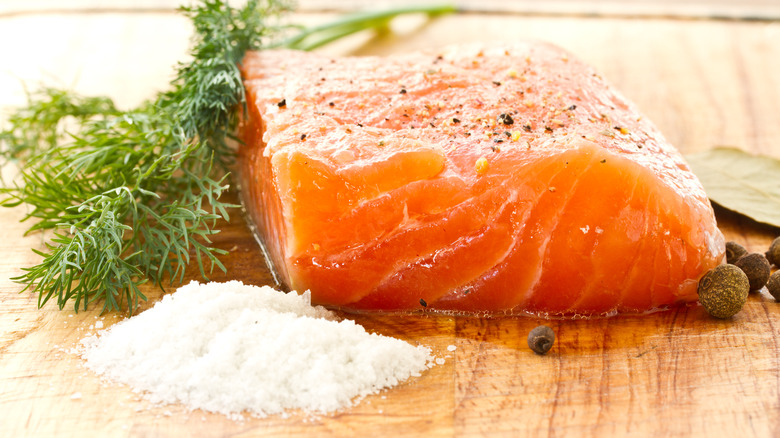The Simple Way To Tell When Salmon Is Done Curing
It's not too difficult to create drool-worthy bagel sandwiches or salmon eggs benedict in your kitchen. That's right, there's no need to wait for Sunday brunch specials! Cured salmon, also known as gravlax, is a delectable delicacy that's surprisingly accessible to the home cook. All it takes is some quality salmon and a bit of patience. But if you've never cured salmon at home before, you'll have to know how to determine when the salmon is done curing. This all hinges on one key element: texture. You'll know the salmon has fully cured based on feel; once the texture is firm when you gently squeeze it, it's ready to go.
Similar to pickling, the outcome of flavor intensity and firmness in cured salmon is determined by the length of time it sits in the brine. The salmon will have a more well-developed texture and flavor the longer it has to cure. There are different ways for salmon curing, but for a quick method, you can get by with the salmon sitting in the brine for just one hour, while four to six hours will give you the best result. Other methods can take 24-72 hours. It all depends on whether you're trying to achieve a medium or hard cure. The curing of salmon takes much less time; that's why it's best to rely on touch to determine when your salmon has finished curing.
Quick curing methods versus traditional curing methods
If you don't have time to cure but have a lot of salmon, you'll first want to slice it thinly. Use boiling water to skin your salmon, as using skinned salmon will speed up the process. These thin slices will absorb the brine faster. Check your salmon slices after about one hour submerged in a bowl of brine in the refrigerator and see if they're firm enough to your liking. If not, place it back in the fridge, keeping in mind the previously mentioned four to six-hour time frame.
A full salmon filet, on the other hand, can take up to a few days to form a firm, powerful cure. The thicker the piece of fish, the longer the curing time. This method also involves pouring half of your brine onto a lined baking sheet, placing the salmon filet on top, and covering the fish completely in the rest of the brine. When the salmon is covered, it'll start curing as soon as you pop it in the refrigerator. Check the fish every 12 hours in that 24-72 hour timeframe for a feel and a flip to let the brine evenly seep into both sides. A hard cure will need a few days to develop, but once it's firm, it's cured.
The best ingredients to use for a perfectly cured salmon
Whether you're preparing a quick cure or using a longer curing method, one thing is universally true: The quality and specificity of your ingredients matter. Beyond buying a high-quality piece of salmon with the bones removed at the store or fish market, there are a few other elements that'll ensure your cured salmon tastes restaurant-quality.
Ordinary table salt should not be used for curing. The salmon will absorb it way too fast and make it very salty. Coarse Kosher salt is ideal. The other key component of the brine is the sugar; granulated white or brown sugar works here. The additional spices and herbs are where you can experiment. Smoked salmon and gravlax have their differences, but both methods of preparing salmon take well to certain spices. You can add some of the typical smoked salmon seasonings like fresh ground peppercorns, cumin seeds, fennel seeds, or chili flakes and chili powder for some spice. No matter the flavor variations of your brine, use your sense of touch to determine when your salmon filet is firm to your liking, and you'll have cured salmon ready to enjoy soon enough.


